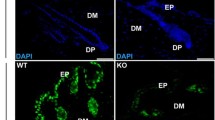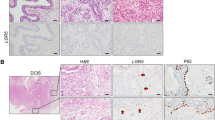Abstract
MI-ER1 is a novel transcriptional regulator that plays a critical role in embryonic development and is differentially expressed in breast carcinoma. The MI-ER1 protein sequence is highly conserved among species, with 95% identity between mouse and humans and 72% between Xenopus and mouse. There are two major protein isoforms, MI-ER1α and MI-ER1β, which differ in the sequence of their C-terminus. MI-ER1α is of particular interest because it contains a consensus LXXLL nuclear receptor interaction motif and the current study was undertaken to determine the expression pattern of MI-ER1α protein in adult mouse tissues. Immunohistochemical analysis of paraffin-embedded tissue using an MI-ER1α-specific antibody revealed that the majority of mouse adult tissues examined showed very weak or no immunoreactivity; these included tissues of the lung, liver, intestine, uterus, spleen, lymph node, bladder as well as skeletal muscle. Interestingly, a subset of endocrine tissues displayed intense staining for MI-ER1α. Specifically, the islets of Langerhans, the zona glomerulosa and medulla of the adrenal gland, the ovary and the hypothalamus were intensely stained. In addition, both anterior and posterior pituitary showed moderate immunoreactivity, as did the parafollicular cells of the thyroid gland and Leydig cells and spermatids in the testes. Negative endocrine tissues included follicular cells of the thyroid gland and the X zone of the adrenal cortex. A few non-endocrine tissues displayed moderate immunoreactivity; these included all tubules and collecting ducts in the kidney, myocardial and endocardial layers of the heart, the hippocampal formation, pyramidal neurons in the cortex and the ductal epithelium of the mammary gland. In all cases, MI-ER1α immunoreactivity was cytoplasmic. This study represents the first immunohistochemical analysis of MI-ER1α expression in mammals and our data suggest that this transcriptional regulator plays a role in specific endocrine pathways.




Similar content being viewed by others
References
Aasland R, Stewart AF, Gibson T (1996) The SANT domain: a putative DNA-binding domain in the SWI-SNF and ADA complexes, the transcriptional co-repressor N-CoR and TFIIIB. Trends Biochem Sci 21:87–88
Bielohuby M, Herbach N, Wanke R, Maser-Gluth C, Beuschlein F, Wolf E, Hoeflich A (2007) Growth analysis of the mouse adrenal gland from weaning to adulthood: time- and gender-dependent alterations of cell size and number in the cortical compartment. Am J Physiol Endocrinol Metab [Epub ahead of print]
Ding Z, Gillespie LL, Paterno GD (2003) Human MI-ER1 alpha and beta function as transcriptional repressors by recruitment of histone deacetylase 1 to their conserved ELM2 domain. Mol Cell Biol 23:250–258
Ding Z, Gillespie LL, Mercer FC, Paterno GD (2004) The SANT domain of human MI-ER1 interacts with Sp1 to interfere with GC box recognition and repress transcription from its own promoter. J Biol Chem 279:28009–28016
Heery DM, Kalkhoven E, Hoare S, Parker MG (1997) A signature motif in transcriptional co-activators mediates binding to nuclear receptors. Nature 387:733–736
Hirokawa N, Ishikawa H (1974) Electron microscopic observations on postnatal development of the X zone in mouse adrenal cortex. Z Anat Entwicklungsgesch 144:85–100
Hishikawa Y, Damavandi E, Izumi S, Koji T (2003) Molecular histochemical analysis of estrogen receptor alpha and beta expressions in the mouse ovary: in situ hybridization and Southwestern histochemistry. Med Electron Microsc 36:67–73
Horlein AJ, Naar AM, Heinzel T, Torchia J, Gloss B, Kurokawa R, Ryan A, Kamei Y, Soderstrom M, Glass CK, Rosenfeld MG (1995) Ligand-independent repression by the thyroid hormone receptor mediated by a nuclear receptor co-repressor. Nature 377:397–404
Jiao Y, Sun Z, Lee T, Fusco FR, Kimble TD, Meade CA, Cuthbertson S, Reiner A (1999) A simple and sensitive antigen retrieval method for free-floating and slide-mounted tissue sections. J Neurosci Methods 93:149–162
Keegan CE, Hammer GD (2002) Recent insights into organogenesis of the adrenal cortex. Trends Endocrinol Metab 13:200–208
Muramatsu M, Inoue S (2000) Estrogen receptors: how do they control reproductive and nonreproductive functions? Biochem Biophys Res Commun 270:1–10
Pascual-Le Tallec L, Lombes M (2005) The mineralocorticoid receptor: a journey exploring its diversity and specificity of action. Mol Endocrinol 19:2211–2221
Paterno GD, Li Y, Luchman HA, Ryan PJ, Gillespie LL (1997) cDNA cloning of a novel, developmentally regulated immediate early gene activated by fibroblast growth factor and encoding a nuclear protein. J Biol Chem 272:25591–25595
Paterno GD, Mercer FC, Chayter JJ, Yang X, Robb JD, Gillespie LL (1998) Molecular cloning of human er1 cDNA and its differential expression in breast tumours and tumour-derived cell lines. Gene 222:77–82
Paterno GD, Ding Z, Lew YY, Nash GW, Mercer FC, Gillespie LL (2002) Genomic organization of the human mi-er1 gene and characterization of alternatively spliced isoforms: regulated use of a facultative intron determines subcellular localization. Gene 295:79–88
Post JN, Gillespie LL, Paterno GD (2001) Nuclear localization signals in the Xenopus FGF embryonic early response 1 protein. FEBS Lett 502:41–45
Sanyal S, Kim J-Y, Kim H-J, Takeda J, Lee Y-K, Moore DD, Choi H-S (2002) Differential regulation of the orphan nuclear receptor small heterodimer partner (SHP) gene promoter by orphan nuclear receptor ERR isoforms. J Biol Chem 277:1739–1748
Sertznig P (2007) Present concepts and future outlook: function of peroxisome proliferator-activated receptors (PPARs) for pathogenesis, progression, and therapy of cancer. J Cell Physiol 212:1–12
Solari F, Bateman A, Ahringer J (1999) The Caenorhabditis elegans genes egl-27 and egr-1 are similar to MTA1, a member of a chromatin regulatory complex, and are redundantly required for embryonic patterning. Development 126:2483–2494
Teplitsky Y, Paterno GD, Gillespie LL (2003) Proline365 is a critical residue for the activity of XMI-ER1 in Xenopus embryonic development. Biochem Biophys Res Comm 308:679–683
Thorne LB, Grant AL, Paterno GD, Gillespie LL (2005) Cloning and characterization of the mouse ortholog of mi-er1. DNA Seq 16:237–240
Wilkinson-Berka JL, Alousis NS, Kelly DJ, Gilbert RE (2003) COX-2 Inhibition and retinal angiogenesis in a mouse model of retinopathy of prematurity. Invest Ophthalmol Vis Sci 44:974–979
Acknowledgements
This work was supported by a grant to LLG and GDP from the Natural Sciences and Engineering Research Council of Canada. LBT is the recipient of a Canada Graduate Scholarship.
Author information
Authors and Affiliations
Corresponding author
Rights and permissions
About this article
Cite this article
Thorne, L.B., McCarthy, P.L., Paterno, G.D. et al. Protein expression of the transcriptional regulator MI-ER1 alpha in adult mouse tissues. J Mol Hist 39, 15–24 (2008). https://doi.org/10.1007/s10735-007-9116-3
Received:
Accepted:
Published:
Issue Date:
DOI: https://doi.org/10.1007/s10735-007-9116-3




